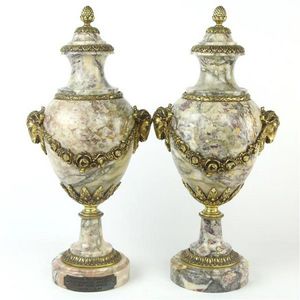Royal Crown Derby Pedestal Vases with Gilded Palmettes
You must be a subscriber, and be logged in to view price and dealer details.
Subscribe Now to view actual auction price for this item
When you subscribe, you have the option of setting the currency in which to display prices to $Au, $US, $NZ or Stg.
- Quatrefoil - A stylised four-circle design, itself contained within a larger circle, with Gothic origins and often seen as window designs in ecclesiastical architecture. The use of the motif was popular in Gothic Revival furniture of the 19th century.
- Circa - A Latin term meaning 'about', often used in the antique trade to give an approximate date for the piece, usually considered to be five years on either side of the circa year. Thus, circa 1900 means the piece was made about 1900, probably between 1895 and 1905. The expression is sometimes abbreviated to c.1900.
- Gilding - Gilding is a method of ornamentation whereby a thin sheet of gold metal is applied to items made of wood, leather, ceramics, glass and silver for decorative purposes.
For furniture including mirrors, the sheet of gold is usually applied over a coating of gesso. Gesso is a mixture of plaster of Paris and gypsum mixed with water and then applied to the carved wooden frames of mirrors and picture frames as a base for applying the gold leaf. After numerous coats of gesso have been applied, allowed to dry and then sanded a coat of "bole", a usually red coloured mixture of clay and glue is brushed on and allowed to dry, after which the gold leaf is applied. Over time parts of the gilding will rub off so the base colour can be seen. In water gilding, this was generally a blue colour, while in oil gilding, the under layer was often yellow. In Victorian times, gilders frequently used red as a pigment beneath the gold leaf.
Metal was often gilded by a process known as fire gilding. Gold mixed with mercury was applied and heated, causing the mercury to evaporate, the long-term effect of which was to kill or disable the craftsman or woman from mercury poisoning. The pursuit of beauty has claimed many victims, not the least of which were the artists who made those pieces so highly sought after today. - Knop (ceramics) - In ceramics, a knop is a protuberance on the top of an object, and can be either decorative, or used as a knob to lift the item.
This item has been included into following indexes:
- Royal Crown Derby (England), item types
Visually similar items

A pair of 20th century Dresden lidded floral encrusted mantle urns, H. 23 cm

Two Vincennes porcelain blue celeste lidded urns with floral and gilt decoration, scalloped feet, height 21.5 cm approx (af to one lid)

A spectacular mid 20th century Royal Worcester large urn vase with id and Griffin handles, richly gilded and with painted fruit pattern, signed T Nutt. Height 36 cm

French marble & gilt bronze pair of urns having goat head handles, applied floral bunting, acorn finials & a plaque inscribed 'Hommage Reconnaissant Des Federations Apicoles À Me Verlinden 1890-1930'. Height 45 cm
